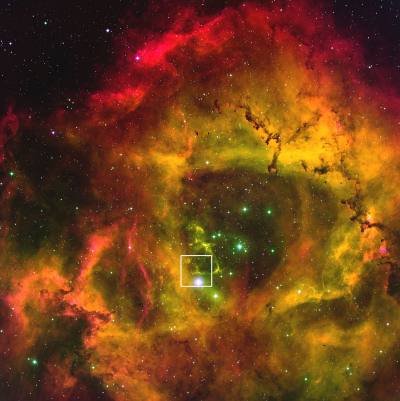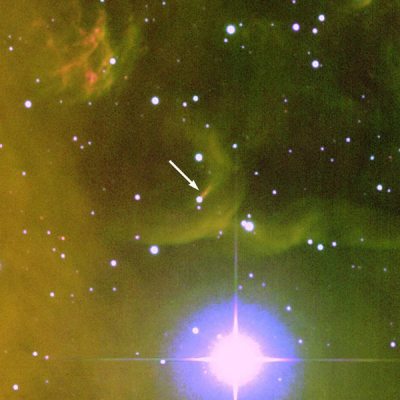Among the busiest and most enigmatic places in the galaxy are star-forming nebulae. Cocooned behind layers of colorful gas and dust, these stellar factories form new generations of hot young stars at their centers. Because the obscuring nascent clouds prevent any clear optical views, studying these secretive newborns has been tricky — until now. Astronomers have made an exciting discovery of a newly minted star that has cast off its nursery veil. As if still undergoing a childish tantrum, it is ejecting a bizarre jet of material peppered with knots and bow shocks never seen before.
Using the Wisconsin-Indiana-Yale-NOAO (WIYN) 3.5-meter telescope at the Kitt Peak National Observatory in Tucson, Arizona, in combination with the 2.16-meter telescope of the National Astronomical Observatories of China, a pair of astronomers captured new optical images of the famous Rosette Nebula that reveal a hot young star stripped of its surrounding gas bubble.
“Most young stars are embedded in very dense molecular clouds, which makes our view of the early stages of star formation normally impossible with optical telescopes,” says coinvestigator Travis Rector of the University of Alaska Anchorage. “This is one of only a few cases where a protostar is visible, making it a valuable discovery that will be studied in detail.”
“If it is indeed a counterjet, it may be the only existing observational evidence of how bipolar jets evolve into monopoles, or at least highly asymmetric jets,” according to coauthor Jin Zeng Li of the Chinese Academy of Sciences in Beijing. “This suggests that this infant star has been starved of material as its accretion disk is evaporated, leaving a very low-mass star.” Li adds that in some cases, this also may explain how substellar objects like brown dwarfs form in such violent, star-forming environments.
Reporting their findings in the December 2003 issue of Astrophysical Journal Letters, the team believes their observations may offer a new evolutionary solution for isolated objects of planetary mass that have been spotted in other emission nebulae scattered across the Milky Way.











